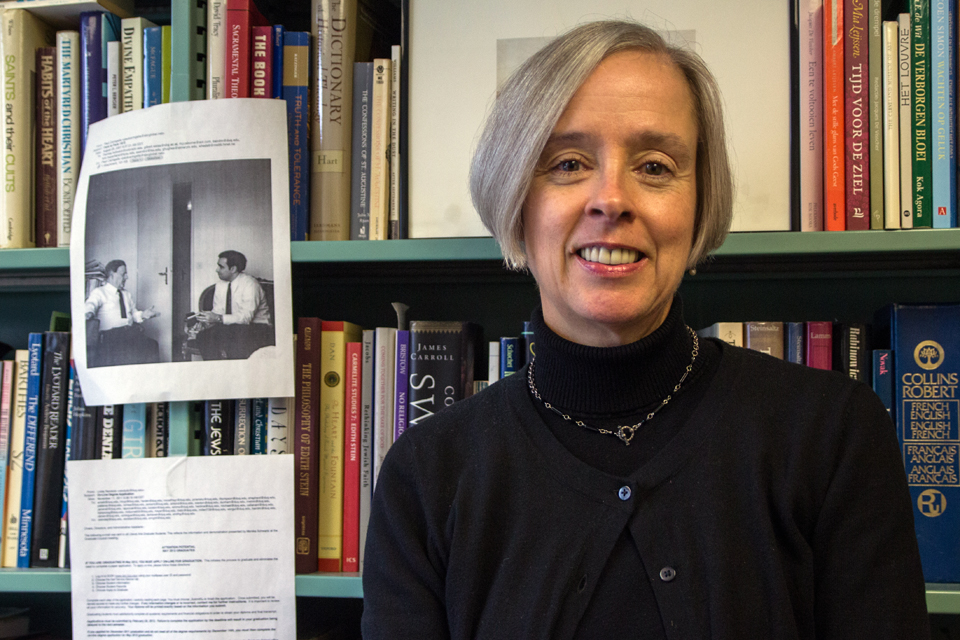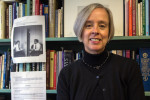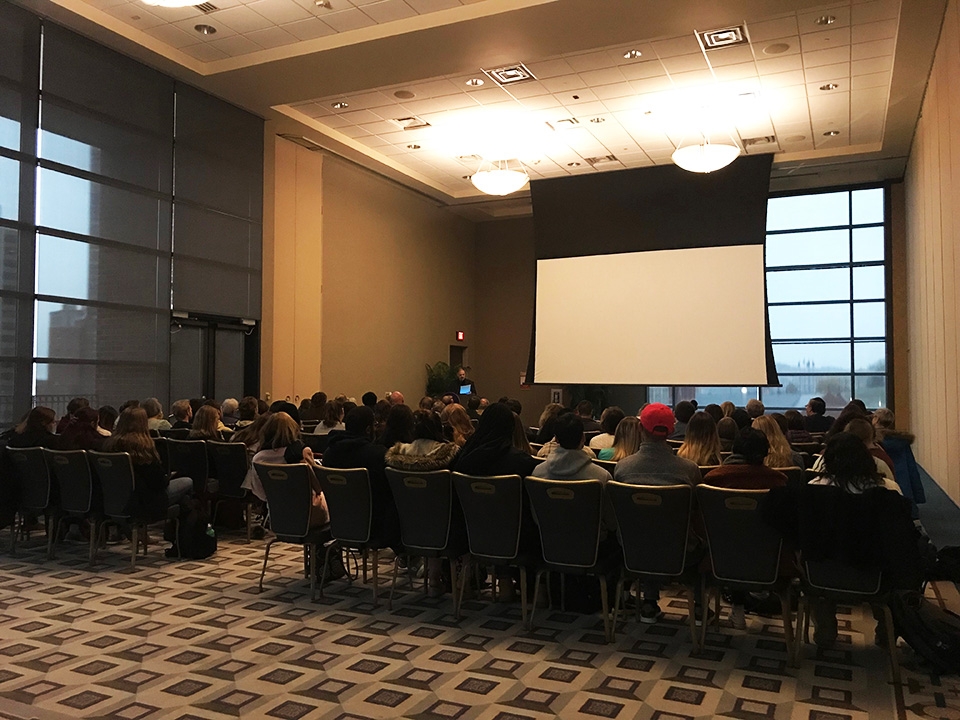
By Sean Ray | a&e editor

The process of bringing “Etty” to Duquesne began when Susan Stein emailed Marie Baird. The play has been performed across the U.S. and Europe.
Duquesne was visited by Susan Stein this week as she performed her one woman play “Etty” at the Genesius Theater in remembrance of Kristallnacht. Kristallnacht (German for Night of Broken Glass) was a series of riots against Jewish store owners that is widely credited as the beginning of the Holocaust. Etty follows the story of Etty Hillesum, a Jewish woman who wrote extensively about her experiences in Nazi Germany before being killed at Auschwitz. The Duke caught up with associate professors Daniel Burston and Marie Baird, who both played an important role in bringing the performance to Duquesne, to get their thoughts on the play and Kristallnacht.
Q: Tell us about Etty and how it relates to the broad historical context of Kristallnacht and the Holocaust as a whole.
Burston: Kristallnacht was a nationwide race riot that engulfed Germany and Austria on Nov. 9 and 10, 1938. The word the Jewish people use to describe these kinds of catastrophes is a pogrom. But this was a pogrom on a scale that hadn’t been seen before. Over a hundred Jewish men were killed, most of the synagogues in Germany and Austria were destroyed, businesses burned and looted, over 600 people beaten and maimed, and 10,000 Jewish men rounded up and sent to concentration camps. So this was the beginning of the end for European Jewry, this night. And that’s what we’re commemorating through this play based on the diary and the letters of one woman who perished at Auschwitz, but whose diaries and letters survived.
Baird: Okay, the focus here is on the diaries and the letters of Etty Hillesum. Hillesum was born in 1914 in the Netherlands, was raised in the Netherlands, was an extraordinarily talented young woman, went to the University of Amsterdam to study law, took a law degree and stayed on to study Slavonic languages. She also had two brothers who were extraordinarily gifted, as were her parents.
She became aware of the reality of what was happening in Nazi occupied Holland as the Nazi occupiers were beginning to take away more and more of the freedom of Dutch Jews in the Netherlands, and this cumulated for her symbolically in April 29, 1942. This was the day the Dutch Jews were forced to wear the yellow star on their clothing as an identifying patch, and that really was for her the turning point where she understood the full reality of what they were actually trying to do and how she began to think that she wouldn’t survive. And so her remaining diary entries and her letters basically become more and more focused on the issue of Jewish survival or not and her sense of a growing relationship with God in the midst of all this.
She ended up working for the Jewish Council, which she did not like and she got out of that job by agreeing to transport a group of Dutch Jews to a transit camp called Westerbork in the northeast of the country. This gained her some privileges; she was able to go back and forth between Westerbork and Amsterdam several times, but ultimately she was shipped out with her parents and one of her brothers to Auschwitz on, I believe it was September 7, 1943. And the Red Cross recounts that she died in Auschwitz on November 30, 1943.
Q: There are so many books and plays about World War II and the Holocaust, whether it’s Night by Elie Wiesel or Anne Frank’s Diary. What do you think Etty adds that others perhaps don’t look at?
Baird: The one thing that Etty’s diaries and letters do is they provide kind of a day-by-day, week-by-week understanding of an extraordinarily gifted young woman who is coming to the gradual realization of what probably lies in wait for her. So her diary entries and letters have a maturity that Anne Frank’s, for example, do not. They also focused on life outside the camp, life before the camp. We have nothing from Hillesum once she was in Auschwitz. She falls completely silent at that point. But this provides an extraordinarily lucid example of a young woman who is coming to grips with a really rational and fairly intense understanding of what probably lies in wait for her and how she may not survive.
Q: Kristallnacht, as an event, tends to get overshadowed in history by what comes later in the Holocaust with Auschwitz and the other death camps. Why do you think it is important to remember Kristallnacht over the other events that occurred?
Burston: It’s not a question of commemorating Kristallnacht over and above but of remembering that event for its distinctiveness because there was still time for all the great powers and for the churches to respond to the plight of the Jews because it was patent what was coming next, and they did not. And that’s why it is important to remember this particular event. It signals not just the beginning of the end of the Jewish people, but their complete helplessness and lack of recourse. We have to remember that the Jewish population of Germany was less than one percent of their total population. They didn’t constitute a threat to anyone, but in the deranged imagination of Hitler and his minions, they were a lethal threat to the great so-called Aryan race, and this was a pretext used to justify the most horrendous violence and no one lifted a finger to stop it.
Q: Do you see yourselves bringing any future plays like Etty to Duquesne, something along the same lines or any similar events like it? Perhaps future plans for next year or anything beyond that?
Burston: There will be a Kristallnacht ceremony of some kind next year, but it might involve a featured speaker, it might involve a musical performance or a play. Our group is not committed in advanced to any one programing format. We want to be creative; we want to give ourselves room to improvise a little bit. Our main objective here, it’s not what kind of performance or program we bring, it’s to bring Holocaust education on campus.
Q: One last question: Duquesne students have very busy schedules, especially with finals coming up. What would you say to students to convince them that they need to see Etty?
Burston: Well, the undergrads I’m teaching right now in my course on psychology as a human science, what I tell them is that we are talking about different theories on human nature; human nature is intrinsically evil vs. human nature is intrinsically good. One of the things that we’re exploring in the wake of all the literature that’s been compiled by experimental psychologists, the work of Stanley Milgrum, of Phillips and Bardo and so on, I’m putting the question to them ‘What sustains your faith in the goodness of human nature.’ Not all of them believe in the goodness of human nature. Some of them are Hobbesian. But I tell them that Etty Hillesum was an example of someone who never lost faith in the basic goodness of human nature despite the fact she was surrounded by sadistic, depraved and merciless human beings herself. She never lost hope in the human race and that this makes her an outstanding and remarkable woman.
Baird: One of the big arguments I raise in my course Faith and Atheism is the problem of evil. And Etty Hillesum is a story of a tragedy, a story of a victimization that should never have happened and it puts a name and it puts a face to the problem of evil, massive evil, genocidal evil. You know, one of the things about genocide is that it’s such an abstraction. We can be talking about hundreds of thousands or millions of people who are killed, but this puts a name and a face. One person who left us with a legacy of writings that we can read and we can call upon and when you can put a name and a face to the problem of evil, it makes it deeply real and deeply personal. And students should see it for that reason alone.


